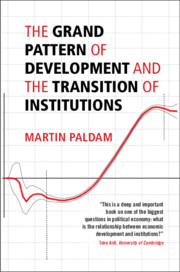5 - The Jumps Model for the Short Run
from Part IIA - The Democratic Transition
Published online by Cambridge University Press: 07 August 2021
Summary
The Polity P-index, 1960–2016, is constant in 7,355 country-years and jumps in 637 country-years, where 199 of the jumps are larger than three Polity points. The deviation of P from the transition curve is defined as the system tension. The Jumps Model states that the transition curve is an attractor for jumps caused by random triggering events. The tensions do explain the larger jumps rather well, while small jumps are random. However, the jumps tend to be larger than the tensions, giving an overshooting pattern of cyclical adjustment. Some of the jumps are a sequence of small jumps in consecutive years. Most changes toward dictatorship are large discrete jumps, while most changes to democracy are sequences. System jumps have a strong grievance asymmetry: Weak growths give more system change, while high growth generates little extra stability.
Information
- Type
- Chapter
- Information
- Publisher: Cambridge University PressPrint publication year: 2021
